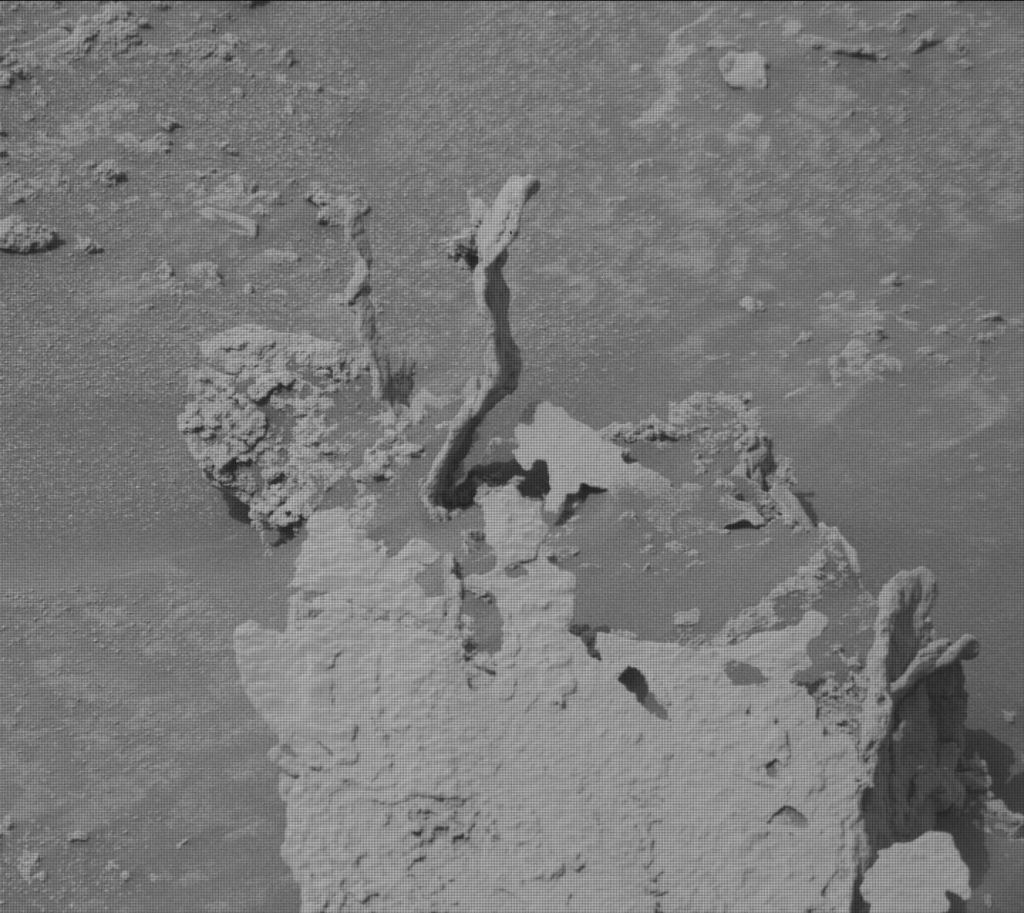In August 2012, the Curiosity rover landed in the Gale Crater on Mars and began exploring the surface for indications of past life. The rover made some profound discoveries during that time, including evidence that the crater was once a huge lakebed and detecting multiple methane spikes. The rover has also taken images of several interesting terrain features, many of which went viral after the photos were shared with the public.
Time and again, these photos have proven that the tradition of seeing faces or patterns in random objects (aka. pareidolia) is alive and well when it comes to Mars! On Sol 3474 (May 15th, 2022), the Curiosity rover’s Mast Camera (Mastcam) snapped a particularly interesting picture showing spikes protruding from the ground. The prongs are likely to be material that survived the erosion of the surrounding sedimentary rock, which is consistent with other evidence obtained by Curiosity that shows how erosion and sedimentary deposits were common in the Gale Crater (and still are).
That being said, the pareidolia crowd (fresh off the “Doorway” hoax) is sure to have a field day with this one! #PPOD: Here is another cool rock at Gale crater on Mars! The spikes are most likely the cemented fillings of ancient fractures in a sedimentary rock. The rest of the rock was made of softer material and was eroded away. ?: @NASA @NASAJPL @Caltech #MSSS fredk, acquired on May 17.
pic. twitter. com/RGfjmRBfI7— The SETI Institute (@SETIInstitute) May 26, 2022 This image was taken by Mast Camera (Mastcam) onboard NASA’s Mars rover Curiosity on Sol 3474 (2022-05-15 13:35:22 UTC).
By May 26th, the photo began making the rounds after The SETI Institute tweeted about it and offered a possible (i. e. , sane and rational) explanation for how the feature formed.
As they explained, the spikes were likely to be “cemented filings of ancient fractures in a sedimentary rock” left behind when the surrounding rock (made of softer material) eroded away. There are two possible mechanisms for this. As scientists have learned, thanks largely to evidence provided by Curiosity, the Gale Crater was once a lakebed that had liquid water flowing into it.
This coincided with the Noachian period (ca. 4. 1 – 3.
7 billion years ago) when Mars had a denser atmosphere, a warmer environment, and flowing water on its surface. The movement of water into the Gale Crater led to the formation of sedimentary features, like the rock layers that form the base of Mount Sharp. While Mars does not experience water-borne erosion today, it still experiences huge dust storms that can erode sedimentary rock faces.
However, the tweet inspired a surge of suggestions and pet theories. A particularly interesting one is that they could be fulgurites, the tubes of glass found in sandy regions that form when lightning strikes and causes silica sand and rock to fuse. While this is a technical possibility, it is highly unlikely.
While some research suggests that lightning could happen during dust storms (as a result of atmospheric particles generating static electricity), lightning has never been observed on Mars. That looks like fulgurite,the result of a lightning pic. twitter.
com/1Eg7RftjkB— El Flo (@ElFlo20) June 6, 2022 What’s more, Mars’ atmosphere is too thin to hold the voltage necessary to generate the kinds of powerful lightning strikes that cause fulgurites here on Earth. Lastly, the fact that Curiosity found this feature would suggest that they are statistically significant, which is not supported by either observational evidence or theoretical research (which suggests its uncommon). In short, any lightning that could take place on Mars would be too rare and too weak to account for a feature like this.
It looks like the smart money is currently on the possibility that this feature was caused by erosion. But that is not likely to dissuade a stream of speculation and crazy ideas! It’s essentially a standing tradition when it comes to Mars. Examples go back as far as Schiaparelli’s “Canali” features, the Viking 1 orbiter’s picture of the “Face of Mars,” the “humanoid,” the “wood plank,” the “Jelly Donut,” the “Dinosaur skull,” and the many, many other instances where people saw things that were not there.
Further Reading: NASA The post Curiosity Sees Bizarre Spikes on Mars appeared first on Universe Today. .
From: universetoday
URL: https://www.universetoday.com/156168/curiosity-sees-bizarre-spikes-on-mars/



